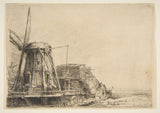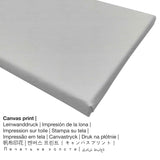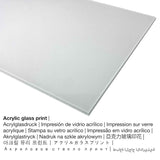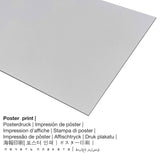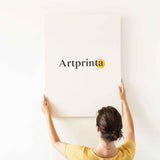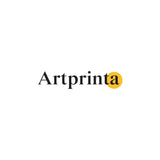Rembrandt van Rijn, 1641 - The Windmill - fine art print
Tax included. Shipping calculated at checkout.
General information from the museum's website (© - The Metropolitan Museum of Art - The Metropolitan Museum of Art)
Rembrandt depicted the boundary between city and countryside. The print shows the so-called Little Stink Mill, an actual windmill that stood on the De Passeerde bulwark along the city wall that ran down the west side of Amsterdam. The mill was owned by the Leathermakers Guild and its nickname derived from its activity of softening tanned leather by treating it with cod liver oil. Rembrandt traced the mill and its surroundings in such detail that it seems likely he began the print on site and then finished it in the studio. Visible in the sky are diagonal striations that result from his having brushed acid over the surface of the printing plate for effect, and craquelure was more likely the result of an accident that occurred as the plate was being bitten by the acid.
Details about the unique piece of art
| Name of the artwork: | "The Windmill" |
| Categorization: | painting |
| Generic term: | classic art |
| Century: | 17th century |
| Year: | 1641 |
| Artwork age: | 370 years old |
| Artwork original medium: | etching, with touches of drypoint |
| Dimensions of the original work of art: | Sheet: 5 7/8 x 8 5/16 in (15 x 21,1 cm) |
| Exhibited in: | The Metropolitan Museum of Art |
| Location of museum: | New York City, New York, United States of America |
| Museum's website: | The Metropolitan Museum of Art |
| Artwork license type: | public domain |
| Courtesy of: | The Metropolitan Museum of Art, New York, Gift of Felix M. Warburg and his family, 1941 |
| Creditline of artwork: | Gift of Felix M. Warburg and his family, 1941 |
Artist details
| Artist: | Rembrandt van Rijn |
| Gender: | male |
| Nationality of artist: | Dutch |
| Jobs: | painter |
| Country of the artist: | the Netherlands |
| Classification of the artist: | old master |
| Art styles: | Baroque |
| Lifespan: | 63 years |
| Year of birth: | 1606 |
| Place of birth: | Leiden |
| Died in the year: | 1669 |
| Deceased in (place): | Amsterdam |
Product specs
| Article classification: | art reproduction |
| Method of reproduction: | digital reproduction |
| Manufacturing process: | digital printing (UV direct print) |
| Origin of the product: | produced in Germany |
| Stock type: | production on demand |
| Intended product usage: | wall gallery, wall art |
| Orientation: | landscape alignment |
| Aspect ratio: | 1.4 : 1 - length : width |
| Implication of the image ratio: | the length is 40% longer than the width |
| Materials: | canvas print, metal print (aluminium dibond), poster print (canvas paper), acrylic glass print (with real glass coating) |
| Canvas print (canvas on stretcher frame): | 70x50cm - 28x20", 140x100cm - 55x39" |
| Acrylic glass print (with real glass coating): | 70x50cm - 28x20", 140x100cm - 55x39" |
| Poster print (canvas paper) size options: | 70x50cm - 28x20" |
| Aluminium print (aluminium dibond material) options: | 70x50cm - 28x20", 140x100cm - 55x39" |
| Frame: | unframed art print |
Order the material you would like to hang up in your home
In the dropdown menu next to the product offering you can pick the size and materialaccording to your individual preferences. Therefore, we allow you to choose among the following options:
- Acrylic glass print (with real glass coating): A glossy print on acrylic glass, often named a UV print on plexiglass, will change your chosen original artwork into lovely wall décor and is a viable alternative to dibond and canvas prints. The artwork is made with the help of modern UV direct printing technology. This creates vivid, impressive colors.
- The canvas print: A printed canvas, not to be mistaken with a canvas painting, is a digital copy applied onto canvas. It creates the special impression of three-dimensionality. Canvas prints are relatively low in weight, which implies that it is quite simple to hang up your Canvas print without the use of additional wall-mounts. Therefore, canvas prints are suited for all types of walls.
- Poster on canvas material: The poster print is a printed cotton canvas with a slight surface structure. The poster is perfectly used for framing your art replica in a customized frame. Please bear in mind, that depending on the absolute size of the poster print we add a white margin 2-6cm round about the print, which facilitates the framing with a custom frame.
- Aluminium dibond (metal print): This is a metal print manufactured on aluminium dibond with an impressive depth effect, creating a contemporary look throuch a surface , which is non-reflective. The Direct Print on Aluminum Dibond is the perfect introduction to reproductions produced on aluminum. For our Direct Aluminium Dibond print, we print the artwork right onto the surface of the aluminum composite. The bright & white parts of the work of art shimmer with a silk gloss, however without glow.
Specifications of the art product
The Windmill is a piece of art created by the painter Rembrandt van Rijn in the year 1641. The more than 370 year old original creation measures the size of Sheet: 5 7/8 x 8 5/16 in (15 x 21,1 cm) and was manufactured on the medium etching, with touches of drypoint. The artpiece is included in the digital collection of The Metropolitan Museum of Art, which is one of the world's largest and finest art museums, which includes more than two million works of art spanning five thousand years of world culture, from prehistory to the present and from every part of the globe.. The classic art work of art, which belongs to the public domain is being included with courtesy of The Metropolitan Museum of Art, New York, Gift of Felix M. Warburg and his family, 1941. In addition to that, the artpiece has the following creditline: Gift of Felix M. Warburg and his family, 1941. Besides, the alignment of the digital reproduction is landscape with a side ratio of 1.4 : 1, which implies that the length is 40% longer than the width. Rembrandt van Rijn was a male painter from the Netherlands, whose art style can primarily be classified as Baroque. The Baroque artist was born in the year 1606 in Leiden and died at the age of 63 in the year 1669.
Legal disclaimer: We try our best in order to describe the art products as clearly as possible and to illustrate them visually. At the same time, the tone of the printed materials and the print result may diverge somehwat from the image on the monitor. Depending on the settings of your screen and the nature of the surface, not all color pigments are printed 100% realistically. Since the fine art prints are printed and processed manually, there might as well be minor deviations in the exact position and the size of the motif.
This text is intellectual property and protected by copyright © | Artprinta.com

